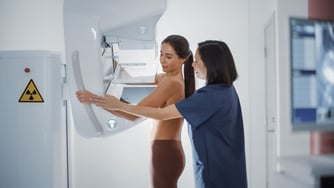
On May 9, 2023 the US Preventive Services Task Force publicly presented their new recommendation statement on breast cancer screening and sought public comment from May 9 through June 5, 2023. Their final recommendations are currently in an “In Progress” status per review of the USPSTF Website.
Major points of interest from the current recommendations
- USPSTF now recommends that average risk women start their screening mammogram routine at age 40 (previously they recommended that women aged 40-50 should only screen based on their individual risk factors).
- USPSTF recommends that these mammograms occur every two years, not annually.
- USPSTF states that there is inconclusive evidence to support or reject recommendations for supplemental imaging with ultrasound and MRI in the 40% of US women with dense breast tissue.
- USPSTF states that there is inconclusive evidence to support screening in women older than 75 years of age.
- USPSTF recommends more research be performed to determine if black women should have alternative screening recommendations given the statistically increased risk of more aggressive cancers at a younger age and the increased mortality in this population compared to the general population in the US.
Right direction, but still inadequate
While the task force is moving in the right direction and admitting that screening women from age 40 to age 50 decreases death rates from breast cancer (they quote 19% more lives saved which I consider a very conservative estimate), the recommendations are woefully inadequate.
Specifically, the frequency of imaging every two years (not annually) is inconsistent with their reasoning for changing the recommendation (ostensibly that younger women are at risk or dying from breast cancer).
Given that breast cancers in younger women tend to be more aggressive and metabolically active (than say an 80-year-old on average), the frequency of two years could be the determining factor between catching a cancer early and letting it progress to a later, less treatable stage.
Greater potential for "years lost' in younger women
 My point is that if we were going to increase the frequency between screening mammograms it would be more safely done in advanced ages, not the younger age group where the likelihood of a more aggressive cancer is greater and the potential “number of years lost” is also greater.
My point is that if we were going to increase the frequency between screening mammograms it would be more safely done in advanced ages, not the younger age group where the likelihood of a more aggressive cancer is greater and the potential “number of years lost” is also greater.
Annual mammograms in this younger group (40-50 years-of-age) are an obvious advantage, if the goal is to save the most lives. And as the radiologist who interprets the images, I can say with certainty that the accurate detection of subtle changes is most likely when multiple sequential years of imaging is available for review and comparison. And unfortunately, two years in the natural history of an aggressive breast cancer can have significant negative outcome consequences.
Women still at risk of preventable morbidity/death from breast cancer
Thus, much like the recommendations of the USPSTF that were presented in 2016 their apparent flawed premise and lack of foundational understanding behind these recommendations put American women at risk of preventable deaths and morbidity from breast cancer. And as before there are still no clinical breast radiologists, breast surgeons, breast medical or radiation oncologists on the “expert” panel.
It is my opinion that the experiential nuances necessary that include the ‘art' of clinical decision-making limits these recommendations. By continuing to ignore decades of substantive evidence and the undisputed fact that annual (yearly) screening mammograms saves the most lives more women in this country will needlessly die from breast cancer. This is even more egregious when a proven and effective screening tool has been and continues to be readily available.
A better approach to breast cancer screening
It is my recommendation that women and their doctors seek their recommendations and advice from the Society of Breast Imaging (SBI) and the American College of Radiology (ACR) regarding breast cancer screening.
Thus, a reasonable, clinically relevant approach for screening for breast cancer would include the following:- Annual screening mammograms starting at age 40 for the average risk population.
- Continued annual screening mammograms for women over 75 if they are in reasonably good health and would treat an image detected cancer.
- Screening high risk women (who have a greater than 20% lifetime risk of developing breast cancer) with supplemental screening breast MRI in addition to annual screening mammogram.
- Average risk women with dense breasts would benefit from supplemental screening with ultrasound in addition to annual screening mammogram.
 In addition, women should take charge of their health by formally assessing their risk profile by age 25 as this will affect their screening recommendations. They should also become proficient in self breast examination (SBE) and perform monthly starting at age 20 and women should request a clinical breast exam (CBE) be performed by their primary provider during their annual well-woman appointment.
In addition, women should take charge of their health by formally assessing their risk profile by age 25 as this will affect their screening recommendations. They should also become proficient in self breast examination (SBE) and perform monthly starting at age 20 and women should request a clinical breast exam (CBE) be performed by their primary provider during their annual well-woman appointment.
About Dr. Connie Jones:
Dr. Connie Jones is a board certified, fellowship trained, dedicated Breast Imaging Radiologist and the author of The Breast Test Book: A Woman’s Guide to Mammography and Beyond (Oxford University Press, 2017). With more than 25 years of clinical breast imaging experience in the community and private practice setting (the arena in which most breast imaging is performed) her opinions are based on the knowledge obtained from interpreting literally tens of thousands of imaging studies and interacting with countless patients, family members, referring providers, and multidisciplinary specialists in breast cancer assessment and treatment. Identifying a need to provide the general public with trustworthy and scientifically accurate breast imaging information in understandable lay language she wrote The Breast Test Book: A Woman’s Guide to Mammography and Beyond as a resource for women and their providers. Follow her on Facebook and Instagram (@thebreasttestbook.com) for ongoing commentary and breast health advice.

Connie Jones, M.D., Fellowship Trained, Breast Imaging Radiologist, Author of: “The Breast Test Book: A woman’s guide to mammography and beyond”
